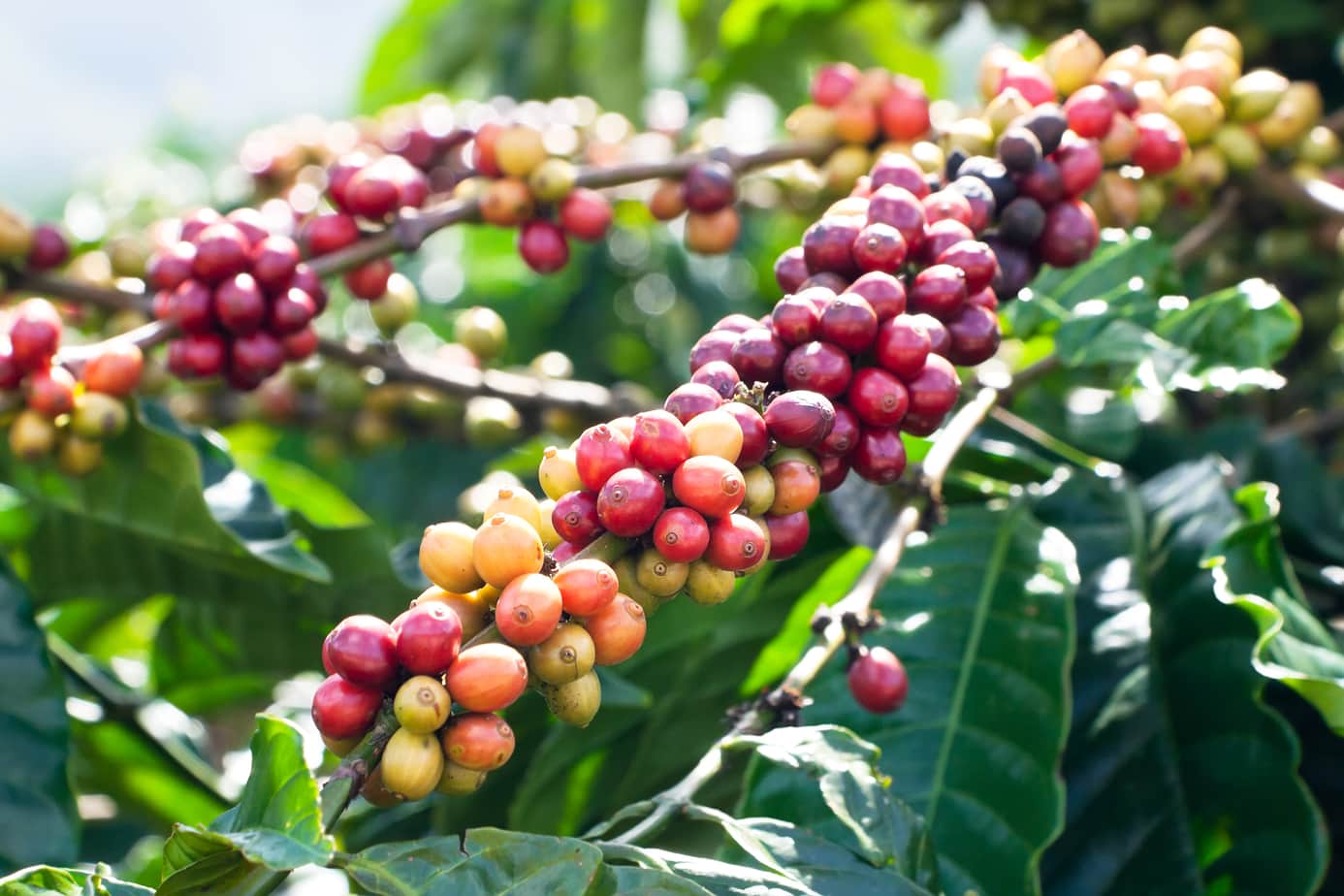Nepal – officially the Federal Democratic Republic of Nepal – is a landlocked country in East Asia. It has an incredibly diverse geography including fertile plain and subalpine forested hills, not to mention eight of the world’s ten tallest mountains, including the highest point on Earth: Mount Everest!
Unsurprisingly, this makes Nepal an excellent place for coffee to grow since the crop thrives at higher altitudes. While the production of Nepal coffee has been slowly increasing over the years, the country has seen steady overseas demand for their delicious, caffeinated crop, particularly when it’s Himalayan.
Itching to know why? Well, we’re itching to tell you, so let’s go!
Getting Started
Nepal’s introduction to coffee started not too long ago, in 1938. We have one man to thank in particular for what became Nepalese coffee and his name was Hira Giri. He was a farmer and an entrepreneur from the Gulmi district, which is one of Nepal’s seventy-seven districts.
He acquired coffee seeds from the Sindo province of Myanmar and brought them back to his home district. He cultivated the land around the nearby Aapchaur Village and planted the seeds. As the plants began to grow and bore fruit, the other farmers in the area took notice.
Ever the generous man who saw the potential in his new crop that was growing nicely, Hiri Giri gave coffee seeds to his fellow farmers. Slowly but surely, the number of coffee beans grown in Nepal started to grow and plantations started to form around the country. At this point, Nepal coffee was only consumed locally.
Worth The Wait
It was only in 1975, when the commercial trading of coffee around the world became extremely popular, that Nepal became certified coffee producers who were in it for the long haul.
It took Nepal’s success in exporting quality coffee for the Nepalis themselves to enjoy coffee. Traditionally, they would only drink instant coffee – even in cafes, restaurants, and hotels, people would be served instant. Oh, the horror! Considered more of a tea-drinking nation, interest in their own product was slow.
Nevertheless, this is a unique and wholesome story of Nepalese coffee history. From one man, coffee growing in Nepal has now stretched across to around forty districts around the country. Let’s dive into what makes Nepal such a great place to grow coffee beans.
An Ideal Country For Coffee Growing
Nepal is considered to be one of the best places in the world for coffee production. In the hillier regions of Nepal, the climate has ensured that the soil remains moist and dense with nutrients, which is perfect for growing coffee beans.
The general sweet spot when it comes to altitude and growing coffee beans is considered to be between 2600ft and 5200ft and it just so happens that much of Nepal’s farming areas fall within these altitudes. When life gives you lemons!
The regions of Nepal in which coffee is cultivated are:
- Ilam
- Sindhul
- Rasuwa
- Ghorka
- Nuwakot
- Dhading
- Palpa
- Guimi
- Rukum
- Baglung
- Kaski
- Tana

Planting The Beans
According to the coffee producers of Nepal, most of the Himalayan coffee has only been planted fairly recently. The standard practice for this coffee is to plant it beside tall trees, so they provide shade for the much smaller coffee plants. It’s a team effort.
Himalayan Coffee
The Himalayas are a mountain range that separates the plains of the Indian subcontinent from the Tibetan plateau. It stretches over five countries: Bhutan, China, Pakistan, India, and of course Nepal. While, sure, it has Mt. Everest, but more importantly, the Himalayan coffee grows there.
Himalayan coffee is mostly grown in at the base of the Ganesh Himal mountain range, which is not far from the capital city of Nepal, Kathmandu. As you can imagine, being in the company of mountains means Himalayan coffee is grown at a very high altitude.
Altitude
Unlike a lot of Nepal’s other coffee beans, these Himalayan coffee beans are grown at around 2,300 feet above sea level. It’s important to know that if the Himalayan farmers cultivated land at a higher elevation and tried to grow the beans there, they would be putting the crops at the risk of frost damage.
The benefits of high elevation are that the cooler mountain temperatures lead to a slower growth cycle in the coffee plants so they have longer to develop which leads to more complex flavors. Not only that, the high elevation means better soil-drainage, so that less water lingers in the fruit which results in a better concentration of flavors.
Altitude is also important in influencing how the coffee bean will taste once it has been ground, roasted, and brewed. The higher the altitude, the more defined and distinctive the taste of the coffee bean will be. Coffees at these high altitudes will often taste fruity and spicy, with hints of berry and wine, so does the Himalayan coffee.
Processing
After harvesting the Himalayan coffee between December and January, the fruit is either wet or dry-processed – in most cases, the former is used.
Specifically, Himalayan coffee cherries are first washed in water. Then they are passed through a pulping machine to separate the coffee bean from the fruit. The beans are then stored separately to ferment. After this fermentation process, they’re washed through again a few times.
After this – and this is the important bit – they are put out to dry in the shade for a two-to-three days before going out into the sun again for the same amount of time. They’re often spread out in rows along large patios – the farmers must rake the beans every six hours to stop the growth of mildew.
Finally, after each of those steps has been completed, these single origin Himalayan coffee beans put inside a huller, a machine that crunches off the parchment skin of the coffee bean before they are ready to be packed up, sold and roasted.
Is it Organic?
Since Himalayan coffee has only been recently cultivated, local farmers claim that the coffee is “organic“. However, very few companies who sell Himalayan coffee advertise the beans as such, as much of it is not certified. But of course, Himalayan coffee is nevertheless grown with care and attention, regardless of the organic certification.
Taste
The taste of Himalayan coffee has been compared to Jamaican Blue Mountain coffee. Now, that’s one big compliment indeed – Himalayan coffee has big boots to fill.
Once roasted, it has a fruity taste with only mild levels of acidity. It is complex and earthy, with chocolate and caramel notes. With its full, velvety body and clean and smooth aftertaste, this Himalayan coffee is a treat to drink.
The only bad thing is that there isn’t more of it. Let us explain…
Potential for More
Nepalese coffee beans – and, more specifically, Himalayan coffee beans – are delicious but not enough people know about them. While the country making sure that coffee is being grown, it is not maximizing its potential.
The farmers also must contend with the large amounts of soil degradation and erosion that affects much of Nepal. Two-thirds of the total area of the country is geologically fragile. Experts are urging that the farmers, social workers, politicians and agriculturists come together to develop strategies for coffee estate sustainability.
Approximately 1,800 hectares produce about 517 tons of coffee. This is tiny when compared to the 11,000 hectares that Nepal has that could be committed to coffee farming – utilizing this potential farming space would potentially yield much more coffee.
By the end of this year (2020), Nepal aims to produce 5,000 tons through the use of these potential farming spaces, extending the humble Nepalese coffee estate to something much bigger.
Coffee is providing great support for the people of Nepal: the crop now supports 32,000 smallholding farmers in 40 of Nepal’s districts.
Quality Over Quantity
The International Trade Centre based in Switzerland conducted a study on Nepal coffee and recommended that they conduct a further push into the specialty coffee market, which is currently worth $48 billion in the US.
The study concluded that Nepal would never be a major seller of huge quantities of their coffee. Instead, the coffee from Nepal is better suited to being sold internationally to specialty traders and small specialty roasters in places such as East Asia, Europe, North America, Australia, and the Middle East who appreciate whole bean, single-origin coffee.

Surfing The Third Coffee Wave
It’s believed that the specialty Himalayan coffee beans of Nepal will be able to capitalize on what is called coffee’s “third wave” by aficionados of the world’s favorite caffeinated beverage, who now see a lot of value in being able to trace the journey of their favorite coffee bean back to its source.
Many people won’t just settle for knowing this great specialty coffee is Himalayan. Instead, they want to also know about the people that worked hard to get it from Nepal’s unique coffee estates to the delicious, roasted beans they grind down for their morning cup.
Coffee’s first “wave” came in the form of companies creating a mass-market coffee. Jars of instant coffee soon appeared in almost every kitchen in almost every country. The second “wave” introduced coffee as more of an art form. A company like Starbucks is a great example of a company that symbolizes the start of this movement.
Cupping Nepal Coffee
A sign that the quality of Nepal coffee beans is being prioritized is that in mid-July of 2018 the country held its first-ever national coffee-cupping in Kathmandu. This is when professional Q-graders (people certified by the Specialty Coffee Association of America) grade and score particular beans on their taste.
Recent improvements like this are a great example of how those involved in Nepal coffee are starting to make a name for themselves, putting their product first and ensuring that the quality of their coffee beans and the process in which they are washed and roasted are unquestionable.
The Need For Knowledge
Nepali coffee farmers bring approximately 50 tons of specialty coffee beans (such as Himalayan beans) to the market each year, which are sold for prices starting at $12 per kilogram. For non-specialty coffee beans, the price is $8 per kilogram.
Raj Kumar Banjara, the co-founder of Nepal’s National Coffee Academy, insists that all those involved in the Nepal coffee business must focus their attention on developing a deeper understanding of the coffee that is being grown.
Currently, there is a lot of inconsistency in the way Nepal coffee is picked, graded, and roasted. This has to change if they want to consistently meet high global standards.
Additionally, with the Nepal coffee business being so small farmers need particular help transitioning to commercial farming, which includes having far larger areas to cultivate their coffee.
Nepal is also in need of new laboratories in which the coffee beans can be tested for their quality. Ensuring the coffee’s quality is the first major step in promoting Nepal coffee internationally – once this has been achieved, experimenting with the coffee beans and developing new flavors can be possible.
Nepal Coffee Culture
For the longest time, Nepal was almost entirely a tea-drinking nation. In not much time at all, Kathmandu has gone from a city teeming with little tea vendors to one that proudly sports café after café! At first, it was mostly tourists that craved a cup of coffee (preferably of the roasted Himalayan variety…) but it didn’t take long for the locals to join in too.
Since the Nepal coffee culture is in its infancy stages compared to other countries around the world, it’s hard to define exactly what makes their coffee culture their coffee culture.
In many ways, it is mimicking the successful café model that has taken off massively in places such as North America and the UK over the last two decades. Free WiFi, newspapers, magazines and books, comfortable chairs and couches and TVs work wonders in getting – and keeping – customers.
The trend of drinking coffee happened quickly, even though Nepal is was and is still a developing country. Before the coffee boom, Nescafé was king, and that was all the Nepalis knew – and wanted to know – about coffee. Processed? Roasted? Organic? Forget about it! Coffee was either black or with milk – that’s it.
But the charm of barista-made coffee drinks can’t be resisted forever – Nepal now has its fair share of fantastic, passionate baristas who are ready to serve customers some delicious beverages with the complex taste of, amongst others, roasted Himalayan beans.
Himalayan Coffee Trading
It wouldn’t be a stretch to say that Nepal’s introduction to barista-made caffeinated goodness wouldn’t be possible without the work of the Himalayan Coffee Trading company.
Established over a decade ago, this company aims to educate the Nepali people about the difference between their beloved Nescafé and Himalayan specialty coffee, often focussing on organic beans. The company has had a huge hand in how coffee culture has grown in Nepal.
Their focus on organic and specialty coffee is inspiring and proof that companies are dedicated to making sure every customer gets the best quality product that’s possible. Organic all the way.
Currently, on Himalayan Coffee Trading’s website, they sell a huge amount of beautiful espresso machines, blenders, bean grinders as well as a wide array of accessories that are important for any budding barista, be it for use at home or in a café.
Barista Training
They also offer great barista training courses for anyone keen to step up their coffee game. They have a basic and advanced barista course, as well as training in perfecting latte art.
Not only do they want the student to be able to serve one mean drink, but they want to make sure their customer service skills are top-notch too. They want to ensure that people passionate about coffee can provide the best experience for customers who are maybe exploring specialty coffee for the first time.
When your local coffee is Himalayan, how could you not be interested in becoming a great barista?
The Best Way To Brew Himalayan Coffee
The earthy, chocolatey taste of much of Nepal coffee means that these beans will lend themselves much better to espresso brewing methods. Utilizing either a Moka Pot or an espresso machine, the espresso that you will pull will highlight the delicious features of the coffee beans.
Haven’t Bean There, Haven’t Done That (Yet!)
There is a lot ahead for the world of Nepal coffee. Himalayan coffee, in particular, is amassing a worldwide fanbase made up of specialty coffee lovers who appreciate all the love and attention that goes into each and every Himalayan coffee bean.
Aside from the appeal of their specialty coffee, there a wide array of tours held in the country for tourists and coffee aficionados who want to explore the process of ‘crop-to-cup’!
You can discover how organic, single-origin coffee cultivated, cared for, and harvested on a Nepalese coffee estate, before being washed and roasted to produce some of the world’s tastiest whole bean goodness.
Want to take a trip there? Us too – it’s too tempting to resist/
Stay caffeinated!







